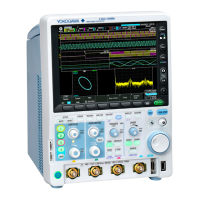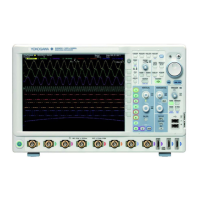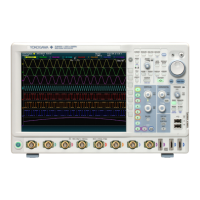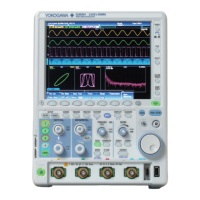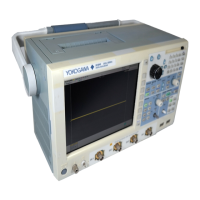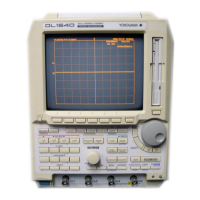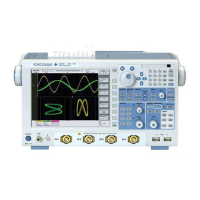App-7
FFT Function
Each frequency component G of a linear spectrum is represented by G=R + jI, where R is the real part and I is
the imaginary part.
Linear Spectrum
The linear spectrum can be directly determined with the FFT. Through this spectrum, the magnitude and phase
of each frequency component included in the measured waveform can be found. The power spectrum and cross
spectrum can also be determined from one or two linear spectra. Because the FFT is a complex function, the
linear spectrum produces the real part and imaginary part of the frequency components. The magnitude and
phase of the linear spectrum can also be determined from this result.
This instrument can determine the following spectra.
Item Formula Computation
Real part LS-REAL R
Imaginary part LS-IMAG I
Bandwidth LS-MAG
Log magnitude LS-LOGMAG
20×log
Phase LS-PHASE tan
−1
(I/R)
Log magnitude reference (0 dB): 1 Vpeak
RMS Spectrum
The RMS spectrum expresses the amplitudes of the linear spectrum with RMS values. It does not contain phase
information.
This instrument can determine the following spectra.
Item Formula Computation
Bandwidth RS-MAG
Log magnitude RS-LOGMAG
20×log
Log magnitude reference (0 dB): 1 Vrms
Power Spectrum
The power spectrum expresses the power (squared value) of each frequency component included in the
measured signal. It is determined by taking the product of the linear spectrum and its complex conjugate. It does
not contain phase information.
This instrument can determine the following spectra.
Item Formula Computation
Bandwidth PS-MAG DC component R
2
+ I
2
AC component (R
2
+ I
2
)/2
Log magnitude PS-LOGMAG DC component 10×log(R
2
+ I
2
)
AC component 10×log{(R
2
+ I
2
)/2}
Log magnitude reference (0 dB): 1 Vrms
2
Power Spectrum Density
The power spectrum density expresses the power spectrum per unit frequency. It is determined by dividing
the power spectrum by the frequency resolution Δf found during the analysis of the power spectrum. The
computation varies depending on the window function.
Power spectrum density is used to compare power spectra analyzed at different frequency bands. However, it is
not necessary for signals having a line spectrum such as sine waves.
This instrument can determine the following spectra.
Item Formula Computation
Bandwidth PSD-MAG PS-MAG/Δf RECT window
PS-MAG/(1.5Δf) HANNING window
PS-MAG/(3.19693Δf) Flattop window
Log magnitude PSD-LOGMAG 10×logPS-MAG/Δf RECT window
10×logPS-MAG/(1.5Δf) HANNING window
10×logPS-MAG/(3.19693Δf) Flattop window
Log magnitude reference (0 dB): 1 Vrms
2
Appendix

